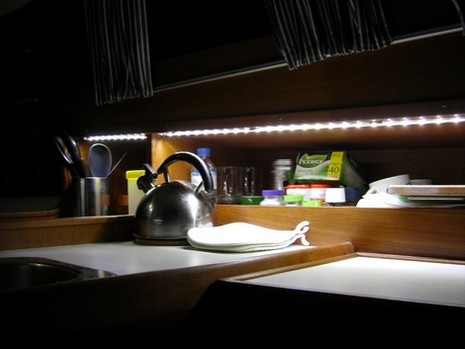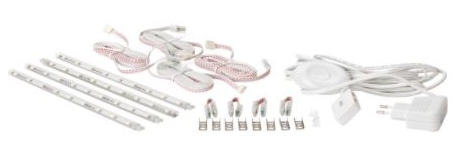LED cabin lighting, from Ikea?

Dutch Panbo reader Eric Criens (thanks Eric!) reports that this good looking LED strip lighting on his 25–year-old Midget 26 (still in production) was easily fashioned from a relatively inexpensive Ikea “Dioder” kit (see below and this alternative). Apparently you can just cut off the transformer and feed 12 volts to the two wires on the white-only strips to get the above. But if you want to go snazzy, Eric says the four wires on the multicolor versions can be fritzed with to produce a choice of white or red illumination. (Report back if you figure out exactly how.)
Eric has also done some interesting AIS/Web programming for his brother’s sailing catamaran, which has purportedly been using the Ikea lights for two years without a failure. I was particularly taken with the Ikea reference because last month I had my first store visit (free water taxis and buses!), and was quite impressed. But actually in terms of boat lighting I’m more interested in LED fixtures made for the purpose, or bulbs that work well in existing boat fixtures. On that latter subject, I’m pleased to note that esteemed Panbot Gram Schweikert (aka “ibsailn”) has done some solid research into various LED bulb options that will hopefully appear here or elsewhere online soon. (Gram, by the way, is planning a major VOJ voyage.)


 Share
Share
I have been waiting for LED lights from Ikea for years.
After my son informed me that an Ikea near Zurich was loaded with LEDs I went to my local US Ikea and found only Christmas-type LED strings. The rest of the lighting department was still halogen with some compact fluorescent.
I have replaced nearly every interior light on my boat with LED clusters from:
http://marinebeam.com/
http://sailorssolutions.com/
http://www.doctorled.com
All have worked well. I have also converted an Ikea desk lamp to a 12v LED cluster.
Jon